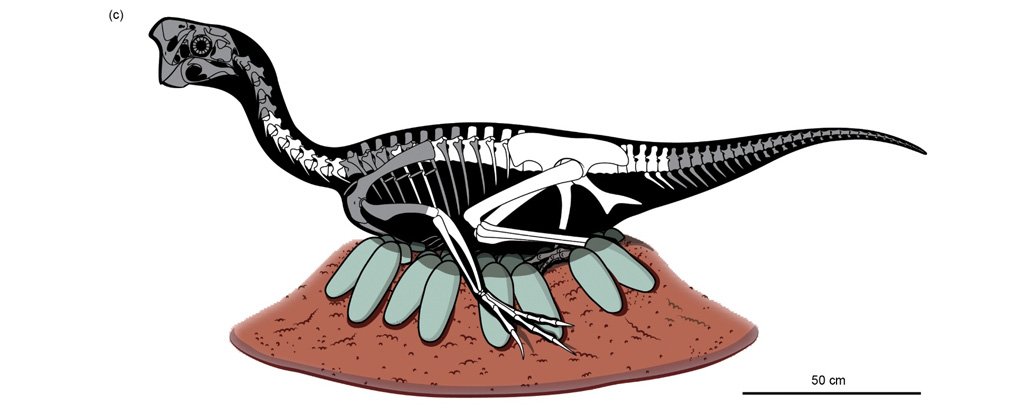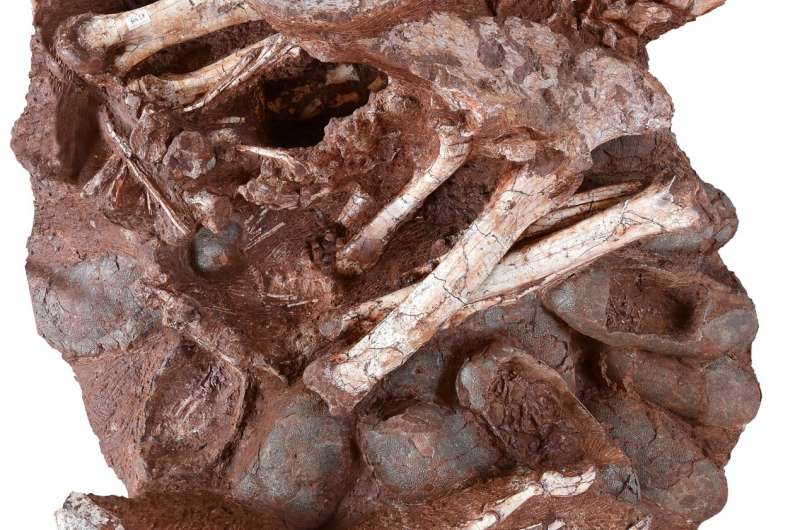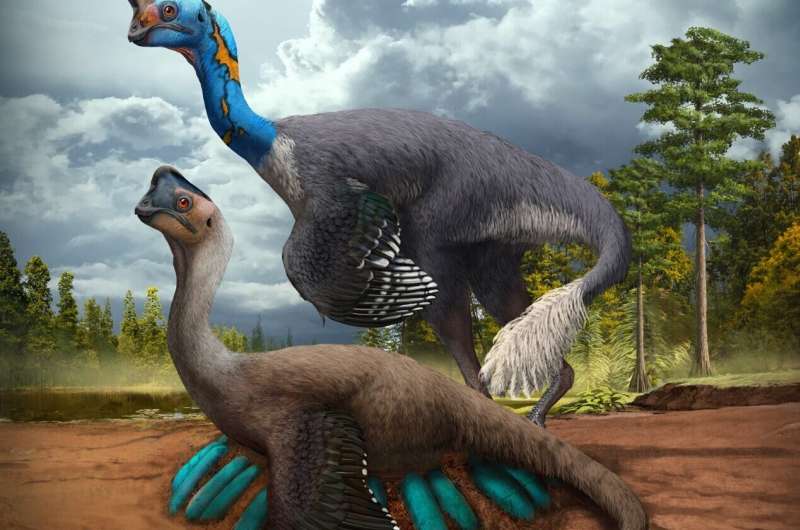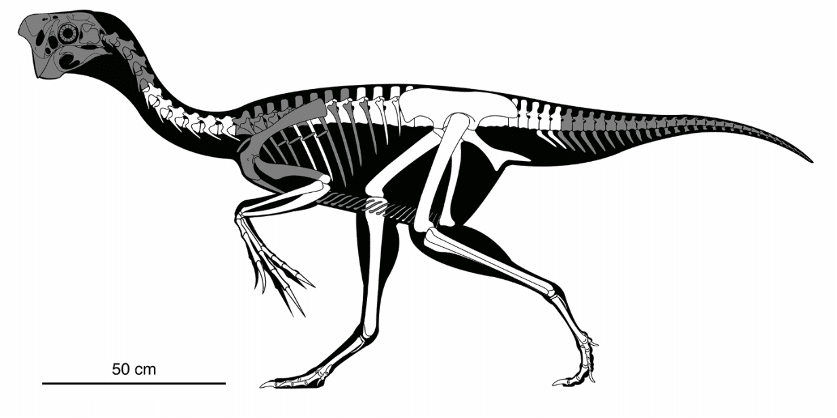
Posted on 03/10/2021 9:22:10 AM PST by Red Badger

Restoration (white indicates bones preserved in the adult skeleton). (Bi et al., Science Bulletin, 2020)
============================================================
An international team of scientists has announced the discovery of an extraordinary fossilized nest in China, preserving at least eight separate dinosaurs from 70 million years ago.
The clutch of ancient eggs belongs to a medium-sized adult oviraptor, and we know that because the parent is actually part of the fossil. The skeleton of this ostrich-like theropod is positioned in a crouch over two dozen eggs, at least seven of which were on the brink of hatching and still contain embryos inside.
The ancient scene is unprecedented, and provides the first hard evidence that dinosaurs were brooding parents, laying their eggs and incubating them for quite a long time.
"This kind of discovery - in essence, fossilized behavior - is the rarest of the rare in dinosaurs," says paleontologist Matt Lamanna from the Carnegie Museum of Natural History (CMNH).
"Though a few adult oviraptorids have been found on nests of their eggs before, no embryos have ever been found inside those eggs."

The 70-million-year-old fossil. (Shundong Bi/Indiana University of Pennsylvania)
===========================================================================
Since the 1980s, paleontologists have unearthed numerous dinosaur nests containing fossilized eggs. Some rare ones have even been found with the parent's skeleton sitting on top. Other oviraptor eggs suggest they might have been a blue-green color.
Inferring behavior from these fossils, however, has proved problematic. While it seems the oviraptor parents are brooding on their nests, it's also possible these dinosaurs perished while laying or guarding their eggs, not necessarily incubating them. This is more similar to how crocodiles deal with their nests, not modern birds.
The new specimen was recovered from the Nanxiong Formation of Ganzhou in South China - a region renowned for the world's largest collection of fossilized dinosaur eggs - but it's unlike anything scientists have found before.
The relationship between dinosaur parent and embryo has never been closer than this. The body of the adult oviraptor is preserved in "extremely close proximity to the eggs", with little to no sediment in between.
In at least seven of the eggs, embryonic material was found exposed, including ossified bones in identifiable shapes.
One of the eggs may actually contain a complete skeleton, with its vertebrae, dorsal ribs, a humerus, both ilia and femora, and a tibia laid out in a curled position.
Analyzing the oxygen isotopes of these embryos, researchers found the estimated incubation temperature was consistent with the body temperature of the parent, sitting somewhere between 30 to 38 degrees Celsius (86 to 100 degrees Fahrenheit).
"In the new specimen, the babies were almost ready to hatch, which tells us beyond a doubt that this oviraptorid had tended its nest for quite a long time," explains Lamanna.
"This dinosaur was a caring parent that ultimately gave its life while nurturing its young."

Artwork of oviraptor dinosaur brooding on a nest of blue-green eggs. (Zhao Chuang/PNSO) ================================================================================
Interestingly enough, however, not all the embryos were at the same stages of development. This suggests the clutch may ultimately have hatched at different times - a feature that was thought to show up much later, in only some types of birds.
While oviraptors are often considered an intermediate stage in this evolutionary process, it looks as though they might have independently moved away from simultaneous hatching, and this suggests the evolution of bird reproduction was not a simple linear process.
Most modern birds will wait until all their eggs are laid before incubating them - sometimes with the help of both mother and father - and this leads to synchronous hatching.
While oviraptors may also have waited to incubate until all the eggs had been laid, the authors suggest the upper eggs might have been closer to the brooding adult and therefore could have developed more quickly. This, however, is just an idea. We'll need more data to figure out why some eggs would have hatched earlier than others.
In other ways, however, the oviraptor shares similar traits to modern birds. The sex of the fossilized parent, for instance, may have been male, which suggests the father might have also taken part in brooding, similar to ostrich mothers and fathers, who take turns incubating their young.
The sex of the adult oviraptor is still under debate (it could be a male or a female based on available data), but the idea matches other analyses of theropod nests, which suggest some level of paternal care.

Artwork of the adult oviraptor skeleton; preserved bones shown in white. (Andrew McAfee/Carnegie Museum of Natural History) ==============================================================================
As if all that reproductive information wasn't enough, this remarkable fossil has also given us a glimpse at the oviraptor's potential diet. For the first time, scientists have found small stones in the stomach of this type of dinosaur, which would have probably been swallowed to aid digestion.
"It's extraordinary to think how much biological information is captured in just this single fossil," says paleontologist Xing Xu from the Institute of Vertebrate Paleontology and Paleoanthropology in Beijing.
"We're going to be learning from this specimen for many years to come."
The study was published in the Science Bulletin.
</sarc>

I really liked that show......................
She died in place, most likely instantly.
Most likely poisonous superheated gases................
We could be more certain about the cause of the encasement if the article had stated the type of material in which the fossils were found. Was it mud or was it volcanic ash? That would tell the tale.
Not the Mama!
Based on the artist depiction, the dinosaur was colored.
I think this makes the cause of death obvious.
/s
Mother birds are amazingly devoted to their young. I once saw a mother duck trying to lead her 10 or so ducklings across a six lane rush hour highway. The mother was ducked down, is the only way I can describe it, and moving slowly, the chicks close behind. I only saw them for a split second as I flew by them in my car, just missing them. I highly doubt she made it, the traffic was too thick, but I will always remember her courage in not abandoning those chicks.
LOL. As Hillary and Chelsea would say..."She persisted."
Was the Democratic Convention in town?
How big of a pan will I need to fry up those eggs?
Thanks Red Badger.
.
Green eggs and ham in the same nest. Good choice SC!
‘Face
;o]
The chicken was involved, the pig was committed! ;^)
That’s the TROOF! Thhpbppbpbpbpbpth!
;o])
“Whatever disaster was that hit them, she did not move!.................”
While this entire image of “real life” is amazing, the disaster and their death is even more interesting. It couldn’t have been a mudslide or anything too violent as that would have disturbed everything. Maybe a volcanic ash deposit that gently covered them like a snow storm - but then had them trapped and preserved?
A regular snow or ice storm could have killed them on the nest - but not preserved them.
I think they just looked up Cassawary in the dictionary and painted it like those huge (and sometimes deadly) birds in Australia.
Good call, killed by the gas, stayed for the ash burial and fossilization.
Early volcano victims discovered
BBC | Monday, May 3, 1999 | editors
Posted on 9/4/2004, 1:59:51 AM by SunkenCiv
https://www.freerepublic.com/focus/chat/1207091/posts
Disclaimer: Opinions posted on Free Republic are those of the individual posters and do not necessarily represent the opinion of Free Republic or its management. All materials posted herein are protected by copyright law and the exemption for fair use of copyrighted works.